

George Couros sur Twitter : ""Up Periscope? New Rules for the Latest Social Media Tool"... The Use of Social Media in Schools. 7 YouTube Tricks You Probably Don’t Know. Youtube is undoubtedly one of the most popular video streaming sites out there.

Whether you want to check out some new music videos or find the latest tutorials to use a software or gadget, the first place that generally pops to mind is YouTube. Despite it being very popular and powerful there are some tricks and features that are still not known by most users. This post intends to deliver tricks that will add more dimension to your experience on the YouTube platform, and allow you to enjoy some of the little-known shortcuts, hacks and special features you can use on Youtube.
Recommended Reading: Useful YouTube Keyboard Shortcuts You Should Know 1. Web 2.0 Diagrams. How are teachers using social media. “The internet: probably the most important human invention since the printing press…” A long-overdue technological revolution in education is at last under way, says The Economist.

This week, The Economist ran a briefing on education technology. As long ago as 1913, Thomas Edison predicted the motion picture would make the book obsolete in the classroom. Though it ‘has been on the verge of transforming education for over a century, this time it looks as though it will’. This time is different, The Economist argues, because of high-speed networks, cheap tablets, big data, online gaming, adaptive software and private equity. History tells a different story. Teachers, who recognise its tendency to fail at the crucial moment, recognise that technology is a good servant, but a poor master. 50+ Reasons Why Parents hate Social Networking sites. Social networking sites are becoming more and more popular among the people of all ages and specially children.
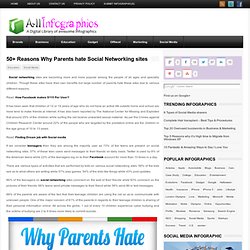
Though these sites have their own benefits but large number of parents hate these sites due to various different reasons. Read: How Facebook makes $115 Per User? It has been seen that children of 12 or 19 years of age who do not have an active life outside home and school are more tend to make friends at internet. It has also been reported by The National Center for Missing and Exploited that around 25% of the children while surfing the net receive unwanted sexual material.
As per the Crimes against Children Research Center around 22% of the people who are targeted by the predators online are the children in the age group of 10 to 13 years. Read: Finding Dream job with Social media. Ten Tips for Becoming a Connected Educator. We all know that education budgets are getting cut more and more, and that meaningful professional-development opportunities have unfortunately become a bit of an oxymoron in education.
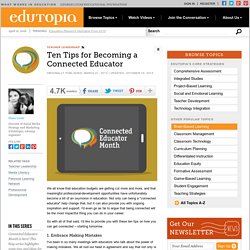
Not only can being a "connected educator" help change that, but it can also provide you with ongoing inspiration and support. I'd even go as far to argue that being connected will be the most impactful thing you can do in your career. So with all of that said, I'd like to provide you with these ten tips on how you can get connected -- starting tomorrow. 1. Embrace Making Mistakes. How to Get Hesitant Teachers to Use Technology. In my consulting as well as administrative technology work, I am often asked the same questions by different schools and officials.

One of the most common is: “How do you get teachers who are hesitant or resistant to use technology?” I am keenly aware that many of my colleagues are not, for various reasons, gung ho about educational technology. And it’s interesting. Quite often, the teachers who are hesitant to adopt new technology are great — in fact, amazing — educators. A Teacher’s Guide to Social Media.
20 Interesting Ways To Use Twitter In The Classroom. 5 Reasons We Use Social Media. 36 Things Every 21st Century Teacher Should Be Able To Do. What should every teacher in the 21st century know and be able to do?
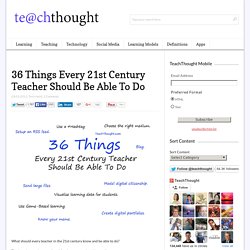
That’s an interesting question. After just now seeing this excellent post on educatorstechnology.com, I thought I’d contribute to the conversation. I added the twist of ranking them from least complex to most complex, so novices can start at the bottom, and you veterans out there can skip right to 36. 36 Things Every 21st Century Teacher Should Be Able To Do 1. Transparent School Leadership: Engaging Social Media as a Strategy. At the NCTIES Conference this week in Raleigh, North Carolina, my presentation was "Transparent School Leadership: Managing Your School or District's Online Reputation.

" The basic premise of the entire presentation was based on these assumptions about school leadership and the engagement of social media.School leaders no longer have a choice of whether to engage in the use of social media if they are going to communicate in a 21st century manner. Our stakeholders increasingly demand that our communication be interactive and multi-way rather than one-way. How Should Social Media Be Taught in Schools? Before we ask how, I think we should address why social media should be taught in schools.
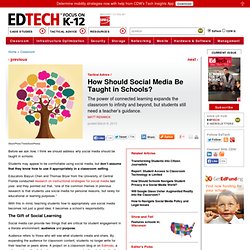
Students may appear to be comfortable using social media, but don’t assume that they know how to use it appropriately in a classroom setting. Educators Baiyun Chen and Thomas Bryer from the University of Central Florida conducted research on instructional strategies for social media last year, and they pointed out that, “one of the common themes in previous research is that students use social media for personal reasons, but rarely for educational or learning purposes.”
With this in mind, teaching students how to appropriately use social media becomes not just a good idea; it becomes a school’s responsibility. A Printable Guide to Social Media [#Infographic] Cram a dozen educators into a conference room and ask them to name the most popular social media tools used by students, and it’s a safe bet everybody at the table could rattle off the top two: Facebook and Twitter.
![A Printable Guide to Social Media [#Infographic]](http://cdn.pearltrees.com/s/pic/th/printable-infographic-magazine-52293609)
But those are far from the only online applications making inroads in schools. As administrators warm to engaging students through social media, the list of potential resources at their disposal grows longer by the day. Facebook and Twitter are the obvious choices. But there are other options — Tumblr, the online blog tool, for instance; YouTube, which doesn’t always get the social credit it deserves; and Google+, the less popular but still-growing social network launched by the search engine giant as an alternative to Facebook, to name three. Is Educational Technology Worth the Hype? Photo credit: iStockPhoto Each January, I have the opportunity to facilitate a course in Leading and Managing Technology for the Educational Leadership Program at St.
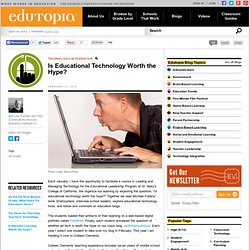
Mary's College of California. We organize our learning by exploring the question, "Is educational technology worth the hype? " Together we read Michael Fullens' book Stratosphere, interview school leaders, explore educational technology tools, and follow and comment on education blogs. The students loaded their artifacts of their learning on a web-based digital portfolio called PathBrite. The Good, the Bad, and the Ugly of Educational Social Media. Image Credit: flickr.com The use of social media for educators to connect, learn and collaborate with each other is so powerful. But in the last six weeks I have been frustrated, discouraged and disheartened by the fact that each Saturday morning the chat I co-founded (#satchat) with Brad Currie (@bcurrie5) has been the victim of spam.
This is unacceptable and a black eye on Twitter. As educators who use social media we should expect, dare I say demand, that all the social media services used to connect us will do so in a manner that provides us with what we want, professional connections with colleagues, in a safe environment and not what we are getting week after week, spam that invades and destroys the very fabric of our efforts. This issue is bigger than our small Saturday morning educational conversation. INFOGRAPHIC: What Makes Social Media so Influential? If your impression of social media is limited to your friends posting cat videos and teenagers glued to their iPhones – think again. Social media possesses incredible influential power, and since the advent of the Internet it’s evolved from a simple way for people to keep in touch into a massive global network connecting organizations, communities and people.
Social media is the easiest, fastest and most explosive way to transmit and receive information! And best of all – absolutely anyone can take advantage of it. Active membership of the most frequented social network is now over one billion people, one out of every seven people on earth is on Facebook! Yes, you read that right – one billion. 7 Steps to Optimize Your Social Media Presence as an Educator. New To Google+? Quick Tips You Need to Know. Google+ was never quite the Facebook killer it was hyped up to be, but it’s been growing steadily ever since it’s been introduced and now has over 100 million active users. Whether you’re just getting started with Google+ or you signed up a while ago and never gave it a chance, these Google+ tips will help get you up to speed with Google’s social network.
Google+ is packed with features and it would take one of our in-depth guides to cover every last thing you can do with it. For more in-depth information, be sure to download Get Into Google+: A Guide for Everyone, our free, in-depth guide to Google+. Manage Your Circles The first thing you should do after signing up with Google+ is manage your circles. For more information about managing your circles, read 7 Must-Know Tips About Managing Your Google+ Circles. Send Private Messages. Social Media in Education: Resource Roundup. Creating Social Media Guidelines A Guidebook for Social Media in the Classroom, by Vicki Davis (2014) Davis, in the first half of a pro-and-con discussion about social media in the classroom, positions it as a vital life skill and provides 12 positive examples of classroom use. For the second half of the discussion, read this post by Ben Johnson: "Too Much Technology and Not Enough Learning?
" The Digital Lives of Teens: What Time Is It? Now!
From Twitter to Edmodo: Schools Collaborate With Social Media. Collaborative Technologies | Feature From Twitter to Edmodo: Schools Collaborate With Social Media Schools are using a variety of social media tools to help students connect and work together. Editor's note: This is the first in a six-part monthly series examining how different technologies can help schools enhance collaboration among students. Here we look at the benefits and challenges of offering access to collaborative learning tools such as blogs, wikis, and discussion boards. Eric Sheninger, the principal at New Milford High School in Bergen County, NJ, is well-known in ed tech circles as an evangelist for the use of web 2.0 tools in K-12 education. 7 Top Tips to Attract EdTech Twitter Followers.
A Useful Social Media Cheat Sheet. If you’re looking for a straightforward no-frills guide that breaks down the details of some of the most popular social networks, look no further. A Great Twitter Cheat Sheet for Teachers. Social Media Video 2013. 5 Tips To Building A Healthy PLN With Twitter. The more I use Twitter, the more I understand the power that comes from connecting. Connecting with friends, connecting with colleagues, connecting with leaders and connecting with valuable sources. It all builds into what has become my most trusted source for professional development and generating ideas. 25 Ways To Use Twitter To Improve Your Professional Development.
Teaching with Twitter: how the social network can contribute to learning. I am senior lecturer in English at the University of Wolverhampton and have been an advocate for the past few years of teaching using blended learning - integrating online learning activities alongside face-to-face teaching. Two of my courses on Victorian literature feature a number of assessed online discussion forum activities. Using Twitter to Bring About Educational Change. Yesterday’s post, Is Twitter the Driving Force Behind Upcoming Educational Change? Examined the ways in which Twitter is a potential driving force for change in education. The conclusion was that, in much the same way social media played a role in the Arab Spring, Twitter and the openness of communication and easy exchange of ideas that it allows for could play a key role in driving educational reform in the near future.
Is Twitter the Driving Force Behind Upcoming Educational Change? Don't Be Afraid of Using Twitter in Business. What Schools are Really Blocking When They Block Social Media. February 2, 2012 PROJECTS: The Digital Edge. Share your great lesson ideas with the world. 10 Little Known Social Media Tools You Should Be Using. Educational Hash Tags and Live Channels. The Oft-Ignored 21st Century Leadership Skill for School Leaders. New Twitter: 25 Tips and Tricks for Savvy Tweeters. The reorganized and refashioned Twitter.com is a markedly different beast than it was just 48 hours ago. “Twitter? I Don’t Get It!” A 3-Step Guide For Newbies - Brandon Twyford – Marketing Communications.
How to Use Google Search More Effectively [INFOGRAPHIC] Among certain circles (my family, some of my coworkers, etc.) I'm known for my Googling skills. I can find anything, anywhere, in no time flat. My Google-fu is a helpful skill, but not one that's shrouded in too much mystery — I've just mastered some very helpful search tricks and shortcuts and learned to quickly identify the best info in a list of results. Sadly, though web searches have become and integral part of the academic research landscape, the art of the Google search is an increasingly lost one. Teaching students about the Creative Commons.
Few changes have been as pronounced in the past decade as the shift from text-heavy content to messages delivered visually. Pairing increasingly sophisticated mobile devices with high-speed connections to the Web and cheap personal video and photography equipment, today’s Internet users have led a visual content revolution. Video sharing sites like YouTube see millions of visitors every month and hours of new content uploaded every minute. A world of tweets. Blog. All My Faves.
How to Grow a Blog » 100+ examples of use of social media for learning C4LPT. The 100 Best Web 2.0 Classroom Tools Chosen By You.